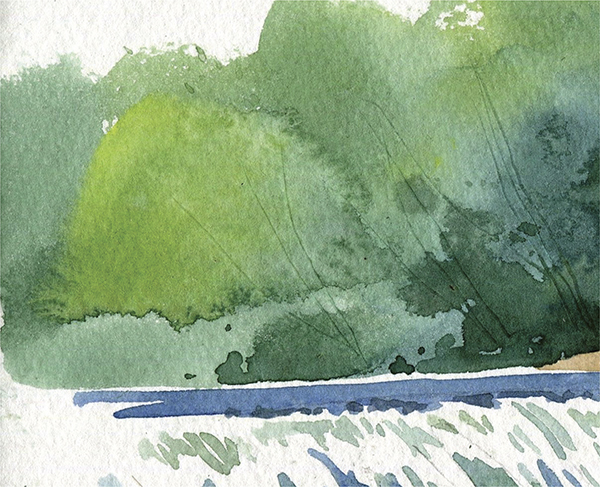
Go with your medium’s strengths, particularly when time is short or weather is threatening. On a recent fishing trip, rain had been falling off and on all day, with more to come. So I dispensed with a great deal of preliminary planning or even elaborate pencil guidelines. I used a simple line to show where the edge of the dam was, and that was enough; I jumped right in with paint.
no. 12 round brush with a sharp end, assorted watercolor pigments, cold-pressed watercolor paper, graphite pencil

STEP ONE: Apply Washes and Initial Texture
I used the slightly rough texture of the paper to suggest foliage at the tops of the distant trees, painting them with a quick drybrush effect. Then, I dropped wetter, lighter-colored paint into the green trees in the background, which made a lacy foliage-like effect as it pushed the dryer pigment back.

STEP TWO: Incorporate Light
I painted around the light-struck edge of the concrete barrier rather than taking time to mask it out, and dropped in a bit of light green in the lower right while it was still wet, both to suggest weeds and to integrate the form.

STEP THREE: Apply Final Touches
Develop the moving water on the dam and add final details as desired.
Before her artist-in-residence trip to Alaska, Nina Khashchina did a great deal of research on what she might need to take and how likely it would be to stand up to extremely wet conditions as well as to rapid change.
Here’s her quick rundown: “Before going to Alaska I did a bit of research on what paper would withstand water/rain and found this ‘rite in the rain’ company that creates paper which is weather resistant. This is what I used while drawing in the rain—in serious rain and while in a kayak. I dropped my pad in the ocean, I splashed it in the tide, it was all over the place and it worked.”

Nina said, “For my Alaska trip, where I drew while ocean kayaking and in the rain, I tried all kinds of pencils: a regular no. 2, a couple of softer pencils, watercolor and colored pencil. The best one for me was Stabilo All Aquarellable pencil 8008. I found that, if you have water, it draws bolder and more liquid lines, almost like paint. I used my fingers and anything that was lying around to try different marks with this graphite. However, if the paper is dry, I prefer Prismacolor pencils.”
If you’re looking for water-resistant paper like the kind that Nina Khashchina used on her Alaskan trip, visit this website: riteintherain.com.